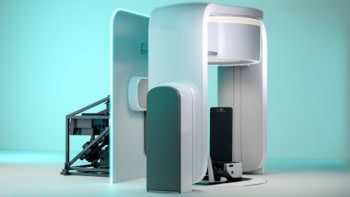In this podcast, Hamish Johnston, editor of physicsworld.com, visits the University of Bristol to find out about the nature of ultrasound and some of its real-world applications. Johnston visits the lab of “professor of ultrasonics” Bruce Drinkwater within the faculty of engineering, where he is treated to a range of demonstrations and learns about some intriguing developments within this research field
Ultrasound refers to a type of vibrational wave that has frequencies above those detectable by the human ear. The most familiar application of ultrasound is perhaps medical imaging, where these high-frequency sound waves are used to scan unborn babies. But Bruce Drinkwater and the researchers in his lab are more interested in developing new applications of ultrasound beyond its traditional uses.
One example is using ultrasound to levitate small objects. In the podcast, Drinkwater explains the physics of this eye-catching phenomenon, in which objects up to a centimetre in size can be trapped in the nodes of an ultrasonic standing wave. You can see the procedure in action in the video below, as University of Bristol PhD student Philip Bassindale delicately creates a “pearl necklace” of levitating polystyrene balls.
Drinkwater explains that his research group has scaled this levitation experiment from one dimension to three dimensions to create a cubic lattice. This system can then be tuned so that it acts as a sound filter. Another exciting possibility is to use the principles of this ultrasonic array to create a “hyper-lens” – a lens that has a resolution beyond the standard diffraction limit. Such a device, explains Drinkwater, could be particularly useful for near-surface medical applications such as detecting and mapping skin cancer.
Later in the podcast, Drinkwater recounts a very different application of his lab’s ultrasound equipment. He and his colleagues were asked if they could use ultrasound to probe the internal structure of the Clifton Suspension Bridge – the iconic Bristol landmark designed by Isambard Kingdom Brunel. The bridge-maintenance team was concerned that cracks might be developing in one of the bridge’s principle supporting structures. Listen to the podcast to find out what they discovered.



